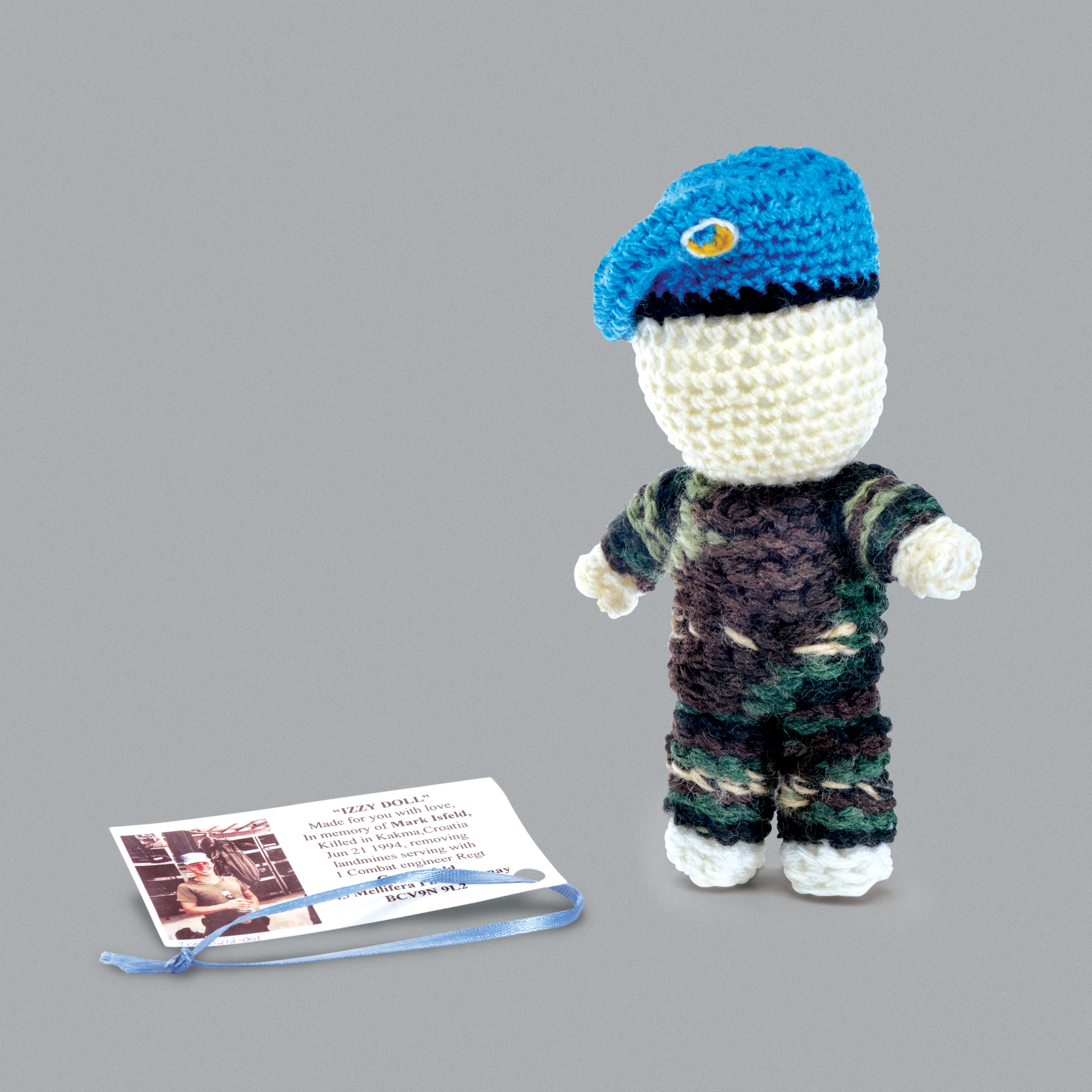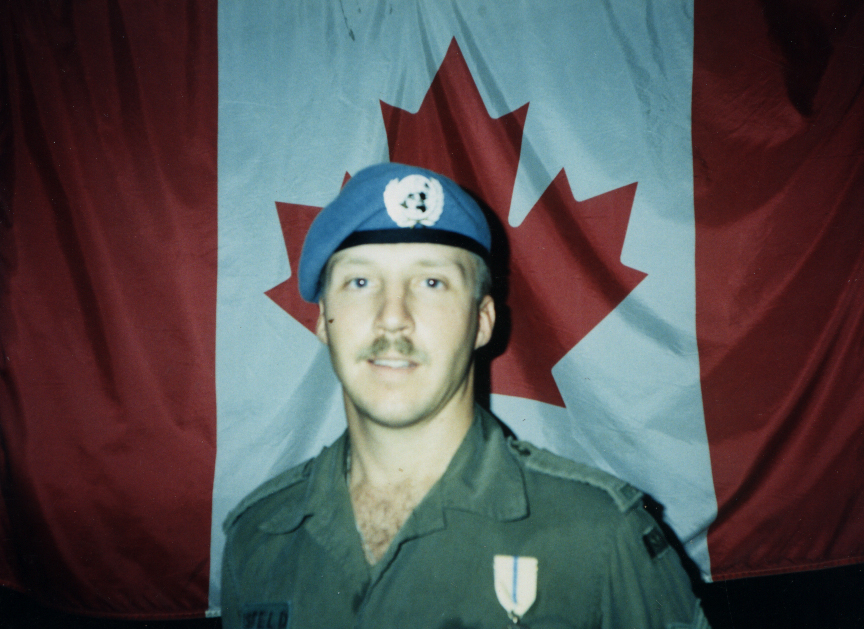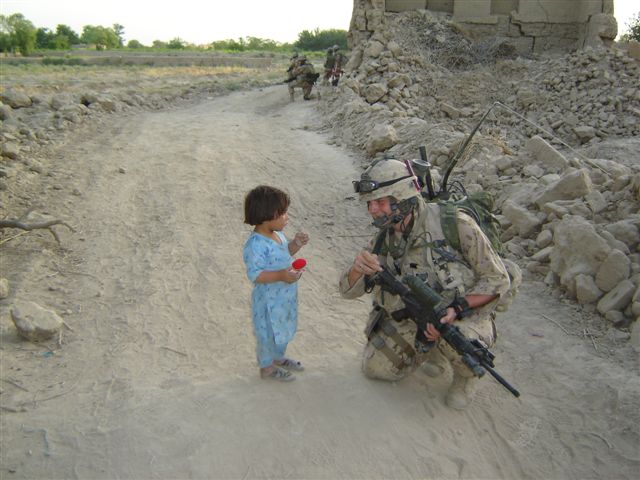Izzy Doll
Artifact
Image
Video
Audio
 Activities
Activities
LOOK
Look closely at this object. What do you think it is? What symbols or colours do you see that give clues about what it might be? Verify your answer by reading the Historical Context below.
THINK
Read about Mark Isfeld’s life and legacy in the Historical Context below. If you could ask him questions about his experience as a peacekeeper, what would they be?
Details
 Materials
Materials - Synthetic
Historical Context
Choose one of the three levels below to match your needs.
- This is an “Izzy Doll.” It is a symbol of Canadian peacekeeping and humanitarian work.
- Corporal Mark (Izzy) Isfeld often gave out small dolls like this one, made by his mother Carol. These dolls were made to bring comfort to children living in war-torn areas.
- Peacekeeping has been recognized as helping to regulate violence between states. However, there have been debates over the usefulness of peacekeeping in recent years.
Scroll through the media carousel above to see a photo of Mark Isfeld and a photo of a child holding an Izzy doll in front of a soldier.
Photos courtesy of the Izzy Doll Project
This is an “Izzy Doll.” It is a symbol of Canadian peacekeeping and humanitarian work.
Peacekeeping has been recognized as helping to regulate violence between states, implementing a monitored ceasefire so that smaller conflicts do not escalate into much bigger wars. Some debates over the efficacy of peacekeeping emerged after the end of the Cold War, and continue to shape public perceptions of peacekeeping in Canada today.
Serving in Croatia in 1994, Master Corporal Mark (Izzy) Isfeld often gave out small dolls like this one, made by his mother Carol. These dolls were made to bring comfort to children living in war-torn areas. Isfeld was killed on June 21, 1994. He was driving near the village of Kakma, when the vehicle hit a tripwire. This triggered a roadside bomb that exploded.
Izzy Dolls are distributed through the Canadian Armed Forces, the International Community for the Relief of Starvation and Suffering Canada (ICROSS Canada), Health Partners International Canada (HPIC) and many other Canadian charities.
This is an “Izzy Doll.” It is a symbol of Canadian peacekeeping and humanitarian work. Peacekeeping is key to Canada’s role in world affairs: more than 125,000 Canadian peacekeepers have served on more than 50 international peacekeeping missions. August 9 is National Peacekeepers’ Day.
Peacekeeping has been recognized as helping to control violence between states, implementing monitored ceasefires so that smaller conflicts do not escalate into much bigger wars. Peacekeeping has had less success in reducing conflict when it takes place inside a country, such as in civil wars or in the case of a failed state. In these instances, there is often no peace to keep.
Some of the debates over the effectiveness of peacekeeping emerged after the end of the Cold War, and continue to shape public perceptions of peacekeeping in Canada today.
Canada was part of several UN peacekeeping missions in the former Yugoslavia during the early 1990s. Serving in Croatia in 1994, Master Corporal Mark (Izzy) Isfeld often gave out small dolls like this one, made by his mother Carol. These dolls were made to bring comfort to children living in war-torn areas.
On June 21, 1994, Mark was guiding a Light Armoured Vehicle (LAV III) down a trail he had cleared of mines the previous day. He was driving near the village of Kakma, when the vehicle hit a tripwire. This triggered a roadside bomb that exploded. Mark died of his wounds shortly afterward.
For more than a decade, Mark’s mother continued to make the dolls, and his colleagues distributed them on their missions. Several friends and other mothers across the country learned of the initiative and joined the project. Word spread, and Carol made the doll pattern available on the Internet so that anyone could make an Izzy Doll and send it to Canadian troops deployed around the world.
Following Carol’s death in 2007, the Isfeld family asked Shirley O’Connell to provide leadership in continuing Mark Isfeld’s legacy. Canadians across Canada have donated more than 1.5 million Izzy Dolls to date, bringing comfort to children suffering as a result of war or natural disasters.
Izzy Dolls are distributed through the Canadian Armed Forces, the International Community for the Relief of Starvation and Suffering Canada (ICROSS Canada), Health Partners International Canada (HPIC) and many other Canadian charities.
- This is an “Izzy Doll.” It is a symbol of Canadian peacekeeping and humanitarian work.
- Corporal Mark (Izzy) Isfeld often gave out small dolls like this one, made by his mother Carol. These dolls were made to bring comfort to children living in war-torn areas.
- Peacekeeping has been recognized as helping to regulate violence between states. However, there have been debates over the usefulness of peacekeeping in recent years.
Scroll through the media carousel above to see a photo of Mark Isfeld and a photo of a child holding an Izzy doll in front of a soldier.
Photos courtesy of the Izzy Doll Project
This is an “Izzy Doll.” It is a symbol of Canadian peacekeeping and humanitarian work.
Peacekeeping has been recognized as helping to regulate violence between states, implementing a monitored ceasefire so that smaller conflicts do not escalate into much bigger wars. Some debates over the efficacy of peacekeeping emerged after the end of the Cold War, and continue to shape public perceptions of peacekeeping in Canada today.
Serving in Croatia in 1994, Master Corporal Mark (Izzy) Isfeld often gave out small dolls like this one, made by his mother Carol. These dolls were made to bring comfort to children living in war-torn areas. Isfeld was killed on June 21, 1994. He was driving near the village of Kakma, when the vehicle hit a tripwire. This triggered a roadside bomb that exploded.
Izzy Dolls are distributed through the Canadian Armed Forces, the International Community for the Relief of Starvation and Suffering Canada (ICROSS Canada), Health Partners International Canada (HPIC) and many other Canadian charities.
This is an “Izzy Doll.” It is a symbol of Canadian peacekeeping and humanitarian work. Peacekeeping is key to Canada’s role in world affairs: more than 125,000 Canadian peacekeepers have served on more than 50 international peacekeeping missions. August 9 is National Peacekeepers’ Day.
Peacekeeping has been recognized as helping to control violence between states, implementing monitored ceasefires so that smaller conflicts do not escalate into much bigger wars. Peacekeeping has had less success in reducing conflict when it takes place inside a country, such as in civil wars or in the case of a failed state. In these instances, there is often no peace to keep.
Some of the debates over the effectiveness of peacekeeping emerged after the end of the Cold War, and continue to shape public perceptions of peacekeeping in Canada today.
Canada was part of several UN peacekeeping missions in the former Yugoslavia during the early 1990s. Serving in Croatia in 1994, Master Corporal Mark (Izzy) Isfeld often gave out small dolls like this one, made by his mother Carol. These dolls were made to bring comfort to children living in war-torn areas.
On June 21, 1994, Mark was guiding a Light Armoured Vehicle (LAV III) down a trail he had cleared of mines the previous day. He was driving near the village of Kakma, when the vehicle hit a tripwire. This triggered a roadside bomb that exploded. Mark died of his wounds shortly afterward.
For more than a decade, Mark’s mother continued to make the dolls, and his colleagues distributed them on their missions. Several friends and other mothers across the country learned of the initiative and joined the project. Word spread, and Carol made the doll pattern available on the Internet so that anyone could make an Izzy Doll and send it to Canadian troops deployed around the world.
Following Carol’s death in 2007, the Isfeld family asked Shirley O’Connell to provide leadership in continuing Mark Isfeld’s legacy. Canadians across Canada have donated more than 1.5 million Izzy Dolls to date, bringing comfort to children suffering as a result of war or natural disasters.
Izzy Dolls are distributed through the Canadian Armed Forces, the International Community for the Relief of Starvation and Suffering Canada (ICROSS Canada), Health Partners International Canada (HPIC) and many other Canadian charities.
Summary
- This is an “Izzy Doll.” It is a symbol of Canadian peacekeeping and humanitarian work.
- Corporal Mark (Izzy) Isfeld often gave out small dolls like this one, made by his mother Carol. These dolls were made to bring comfort to children living in war-torn areas.
- Peacekeeping has been recognized as helping to regulate violence between states. However, there have been debates over the usefulness of peacekeeping in recent years.
Scroll through the media carousel above to see a photo of Mark Isfeld and a photo of a child holding an Izzy doll in front of a soldier.
Photos courtesy of the Izzy Doll Project
Essential
This is an “Izzy Doll.” It is a symbol of Canadian peacekeeping and humanitarian work.
Peacekeeping has been recognized as helping to regulate violence between states, implementing a monitored ceasefire so that smaller conflicts do not escalate into much bigger wars. Some debates over the efficacy of peacekeeping emerged after the end of the Cold War, and continue to shape public perceptions of peacekeeping in Canada today.
Serving in Croatia in 1994, Master Corporal Mark (Izzy) Isfeld often gave out small dolls like this one, made by his mother Carol. These dolls were made to bring comfort to children living in war-torn areas. Isfeld was killed on June 21, 1994. He was driving near the village of Kakma, when the vehicle hit a tripwire. This triggered a roadside bomb that exploded.
Izzy Dolls are distributed through the Canadian Armed Forces, the International Community for the Relief of Starvation and Suffering Canada (ICROSS Canada), Health Partners International Canada (HPIC) and many other Canadian charities.
In-Depth
This is an “Izzy Doll.” It is a symbol of Canadian peacekeeping and humanitarian work. Peacekeeping is key to Canada’s role in world affairs: more than 125,000 Canadian peacekeepers have served on more than 50 international peacekeeping missions. August 9 is National Peacekeepers’ Day.
Peacekeeping has been recognized as helping to control violence between states, implementing monitored ceasefires so that smaller conflicts do not escalate into much bigger wars. Peacekeeping has had less success in reducing conflict when it takes place inside a country, such as in civil wars or in the case of a failed state. In these instances, there is often no peace to keep.
Some of the debates over the effectiveness of peacekeeping emerged after the end of the Cold War, and continue to shape public perceptions of peacekeeping in Canada today.
Canada was part of several UN peacekeeping missions in the former Yugoslavia during the early 1990s. Serving in Croatia in 1994, Master Corporal Mark (Izzy) Isfeld often gave out small dolls like this one, made by his mother Carol. These dolls were made to bring comfort to children living in war-torn areas.
On June 21, 1994, Mark was guiding a Light Armoured Vehicle (LAV III) down a trail he had cleared of mines the previous day. He was driving near the village of Kakma, when the vehicle hit a tripwire. This triggered a roadside bomb that exploded. Mark died of his wounds shortly afterward.
For more than a decade, Mark’s mother continued to make the dolls, and his colleagues distributed them on their missions. Several friends and other mothers across the country learned of the initiative and joined the project. Word spread, and Carol made the doll pattern available on the Internet so that anyone could make an Izzy Doll and send it to Canadian troops deployed around the world.
Following Carol’s death in 2007, the Isfeld family asked Shirley O’Connell to provide leadership in continuing Mark Isfeld’s legacy. Canadians across Canada have donated more than 1.5 million Izzy Dolls to date, bringing comfort to children suffering as a result of war or natural disasters.
Izzy Dolls are distributed through the Canadian Armed Forces, the International Community for the Relief of Starvation and Suffering Canada (ICROSS Canada), Health Partners International Canada (HPIC) and many other Canadian charities.



